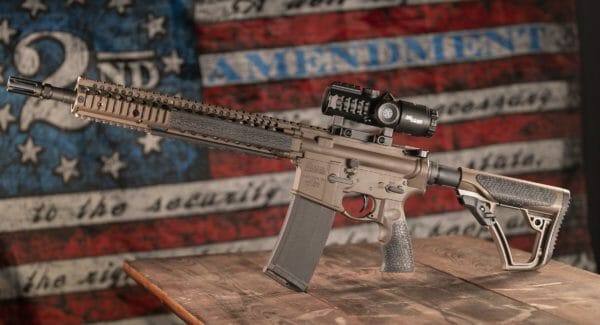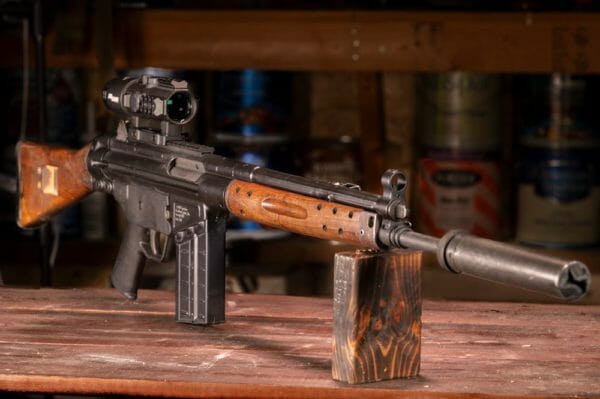
Prismatic optics like the SIG Bravo 5 used to be relatively uncommon in the world of firearms. The market was basically dominated by Trijicon’s ACOG and to a smaller degree, the Elcan Spectre series of combat optics. And a few years back, SIG sought to change all that with the introduction of a few solid optics that while good, wasn’t up to snuff with some of its competitor’s offerings.
Since then, SIG has increased both the quality and number of prismatic scopes in their optics line-up. But even with all these improvements can SIG go toe-to-toe with more established prismatic-optic-makers? Let’s take a closer look at the Bravo 5 and find out.
SIG Bravo 5
For starters, the SIG Bravo 5 is a fixed-magnifications, prismatic five-power scope. The body is constructed from black anodized aluminum and has a waterproof rating of IPX-7 or roughly being submerged under 13 feet of water. The Bravo 5 is a fairly light optic given its robust construction, tipping the scales at 23oz.
As far as features, the Bravo 5 can be adjusted up to 80 MOA for both windage and elevation and includes an excellent BDC horseshoe reticle. (The optic’s zero is adjusted 0.5 MOA per click.) This reticle has subtension holdovers for hitting targets from 300 to 800 yards in 100-yard increments. The horseshoe itself is illuminated, making it function as a makeshift red dot for close-range targets while aiding the shooter by drawing their eye to the reticle.

Another interesting feature of the Bravo is its use of a proprietary built-in Picatinny mount. Personally, I would have preferred if SIG utilized a more common ACOG mount for the sake of shooters being able to utilize existing mounts – especially firearm-specific ones like the RS Regulate AKOG. That said, the included mount features two hexagonal bolts that feature a small hole in them for users to stick an Allen key, a small punch, or whatever they have on hand to easily tighten or loosen if need be.
Light reception from the 32mm Bravo is fantastic, easily on par with the original ACOG. Although like the ACOG, the Bravo also suffers from relatively short eye relief. In fact, the eye relief on the Bravo is just a hair over two inches, but given that the optic is designed primarily for AR-15s and SIG’s MCX, this makes sense; the recoil on both these firearms is minimal.
Bravo 5 Testing
To test the Bravo 5, it was initially mounted on a Daniel Defense DDM4 V7 carbine where it saw some 250 rounds fired through the gun. The mount never loosened, and the zero stayed consistent. I then decided to mount it on something with a little more recoil and installed it on my Century Arms C308 carbine chambered in .308 Win.

Here too, the Bravo held perfectly, and really helped maximize the increased effective range of that caliber by providing a clear, bright sight picture. Though the relatively short eye relief was a little uncomfortable on the very long length-of-pull CETME stock on the C308, but keep in mind that the author is only 5’9″. Even still, I had to essentially mount the optic as far back as possible to achieve a proper, comfortable sight picture.
Verdict
So, is the SIG Bravo 5 an ACOG-killer? For some buyers, yes.

Yes, the Bravo offers excellent performance and solid build quality along with a host of desirable features. It also boasts a very attractive MSRP of $481.99 – substantially cheaper than military-grade prismatic scopes. That said, I’m all but certain that the Bravo 5 isn’t capable of taking the same kind of beating as military-grade combat optics like the Elcan Spectre or Trijicon ACOG. But with a price less than a third of the Elcan, that is to be expected.
About Jim Grant
Jim is a freelance writer, editor, and videographer for dozens of publications who loves anything and everything guns. While partial to modern military firearms and their civilian counterparts, he holds a special place in his heart for the greatest battle implement ever devised and other WW2 rifles. When he’s not reviewing guns or shooting for fun and competition, Jim can be found hiking and hunting with his wife Kimberly, and their dog Peanut in the South Carolina low country.

